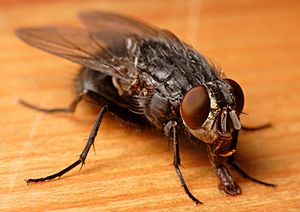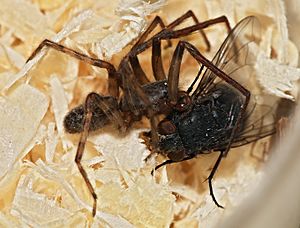Calliphora vicina facts for kids
Quick facts for kids Calliphora vicina |
|
|---|---|
 |
|
| Scientific classification | |
| Kingdom: | |
| Phylum: | |
| Class: | |
| Order: | |
| Family: | |
| Genus: |
Calliphora
|
| Species: |
C. vicina
|
| Binomial name | |
| Calliphora vicina Robineau-Desvoidy, 1830
|
|
| Synonyms | |
|
|
The Calliphora vicina is a type of fly known as a blue bottle fly. It belongs to the Calliphoridae family. These flies are very important in a special science called forensic entomology. This field uses insects to help figure out how long a body has been deceased.
C. vicina is one of the most useful fly species for this purpose. It arrives at a body after death in a very predictable way. This helps scientists estimate the time of death.
Contents
About the Blue Bottle Fly
Naming and Family
The French scientist Jean-Baptiste Robineau-Desvoidy first described C. vicina in 1830. Its name comes from the Latin word vicinus, which means 'neighbouring'.
C. vicina is closely related to another important fly, Calliphora vomitoria. Both are used in forensic studies.
What Does it Look Like?
C. vicina is called a blue bottle fly because its body is a shiny blue-gray color. This metallic color is on its thorax (middle part) and abdomen (tail end). You can tell it apart from C. vomitoria by its bright orange cheeks.
These flies are about 10–11 mm long. The parts at the base of their legs are yellow or orange. Scientists can also identify them by looking at their bristles. Blue bottle flies have black bristles on a part called the meron. They also have two or three bristles on their notopleuron.
It can be very hard to tell young Calliphora species apart. From the first instar (larva stage) to the pupa stage, C. vicina looks just like C. vomitoria.
Life Cycle of the Fly
C. vicina can have five generations in one year. This happens when the temperature is around 27˚ C (81˚ F). A female C. vicina can lay up to 300 eggs. She lays them on fresh dead animals or open wounds.
The larvae (maggots) go through three growth stages called instars.
- The first instar hatches about 24 hours after the eggs are laid.
- It becomes a second instar in 20 hours.
- It reaches its third instar in 48 hours.
If conditions are good, the larvae feed for about three to four days. Once they are fully grown, they move away to find a safe place to turn into a pupa. The pupa stage for C. vicina lasts about 11 days. At 27˚ C, the whole life cycle takes about 18 days.
Weather, especially temperature, affects how fast they grow. In warmer weather, the life cycle is quicker. In cooler weather, it takes longer. Knowing how long each stage takes helps scientists estimate the time of death in investigations.
Where Do They Live?
C. vicina flies are common in cities across the U.S. They are most active in early spring and fall. This is when temperatures are between 13-24˚C (55-75˚F).
These flies are very common in Europe and the Americas. They have also traveled to other countries. They often arrive via harbors and airports. For example, they were first seen in South Africa in 1965. They are also found in Australia and New Zealand.
How Flies Help Solve Mysteries
Estimating Time of Death
One important way blow flies help is by showing up on a body in a specific order. Different insects arrive at different times after death. By looking at which insects are present, scientists can estimate when death happened. C. vicina has its own special role in this process.
C. vicina is especially important in colder months. It is less common in warmer weather. This fly can fly and be active at lower temperatures than other blow flies. This means you see them more often when it's cold. Scientists must remember this activity period when studying a body.
When using the age of maggots to estimate the time of death, scientists also consider when the adult flies first arrived. Adult C. vicina usually arrive about two days after death. So, two days must be added to the age of the oldest flies found on the body.
Fly Behavior and Clues
C. vicina behavior is key to figuring out the time of death. Scientists consider many things. These include the region, weather, time of day, and how the body was found. To make a good estimate, an entomologist combines known facts about C. vicina with information from the scene.
The entomologist needs to know how the fly acts in that specific area. This means recording temperatures at the scene. They also check past climate records for the region. C. vicina likes cooler temperatures. They are most common in winter. Their flight activity starts above 13-16 °C (55-60 °F). This is a lower temperature than most other blow flies. Knowing this helps scientists calculate "accumulated degree days," which helps estimate the time of death.
Some things about C. vicina behavior are well known. Studies show they are not the very first flies to arrive. However, they usually appear one or two days before Phaenicia sericata. Figuring out the time of death is complex. There is still much to learn about C. vicina behavior. For example, it was once thought they were not active at night. But recent studies show they can be active at night under certain conditions.
Future Discoveries
As scientists continue to study C. vicina, they will learn more about its behavior. This will give a more complete picture of its life cycle. This new knowledge will help forensic entomologists make even better estimates of when a body was colonized by flies. Learning about things like C. vicina's night activity gives them better tools for their important work.



